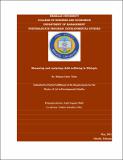| dc.description.abstract | In Ethiopia out of the total population of the country, the younger population under age 15 is almost 45% of the country‟s population. The purpose of this research is to identify the wellbeing status of children in the country. For measure and analyze child wellbeing in Ethiopia the appropriate method for analyzing the data was by using Z score for each variables, by average z score value of the variables form a domain and by average z score value of the domains to form a cluster and finally by average of the cluster form index child wellbeing. To know which of the variable affects the domain or the cluster correlation and covariance between the variables or the domains was made. The general framework of the study was developed from FCD-Land index for US and that of Bradshaw for European. While the living conditions of people of the country in general gained increasing recognition but the wellbeing status of children is not monitored on country base. Therefore, to find wellbeing status of children across the country and ranking them across the five regions this paper brings new concepts. The base for this research was different opportunity and legal base of children for their survival therefore; it was based on a rights-base and multi-dimensional understanding of child wellbeing. The research analyzed longitudinal data collected since 2002 available from young lives project that was collected to address the achievement of Millennium Development Goal in Ethiopia in addition to another four countries like India, Vietnam And Peru. The data for addressing the wellbeing status and ranking of the regions on child wellbeing the index was classified in to seven clusters( material situation, health, education, housing, subjective well-being, , children‟s relationships and risk and safety) with in these cluster there are domains and within the domains there are indicators. Therefore for analyzing child wellbeing the latest version of both Special Package for social Science (SPSS) and that of STATA was applied for simplifying the work. | en_GB |


